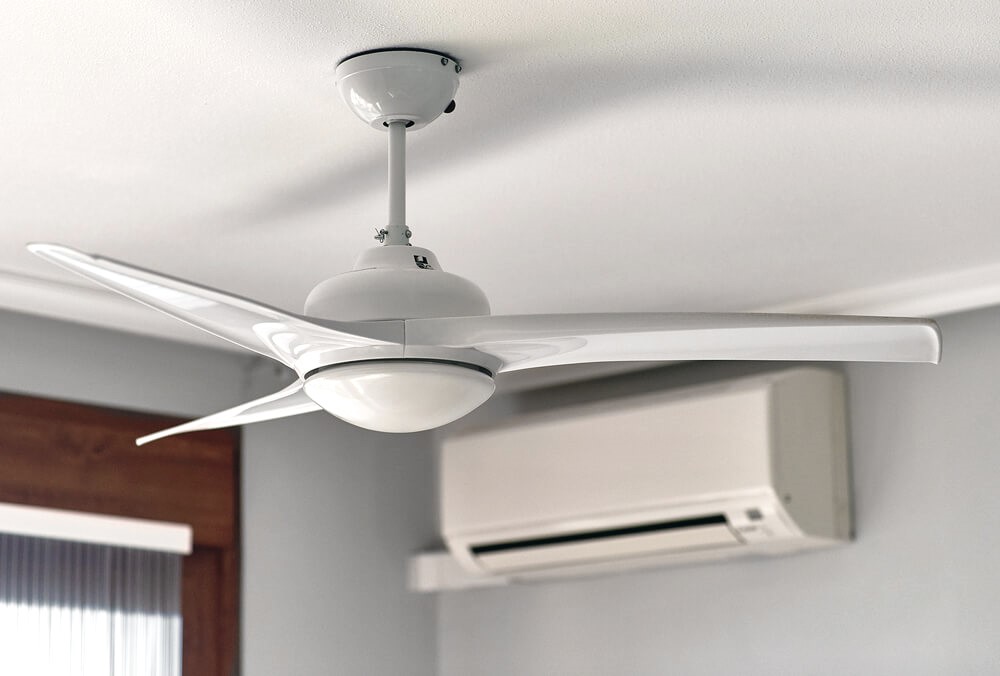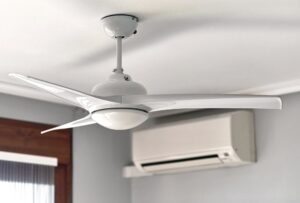Ceiling Fans
Ceiling fans are a common sight in Australian homes, and for good reason! They are a staple appliance that helps us combat the hot climate.
Unlike air conditioners, however, the average indoor ceiling fan doesn’t directly cool the air. Instead, they use a concept called the “wind chill effect.” As the blades rotate, they push the air down, creating a breeze on your skin. This windchill makes you feel cooler, even though the actual air temperature remains unchanged.
There are different types of ceiling fans available in the market. Some fans have quieter motors compared to others while some fans come equipped with integrated lighting and remote controls.
By knowing your home’s needs and understanding how ceiling fans work in general, you can decide if they’re the right cooling solution for your home.
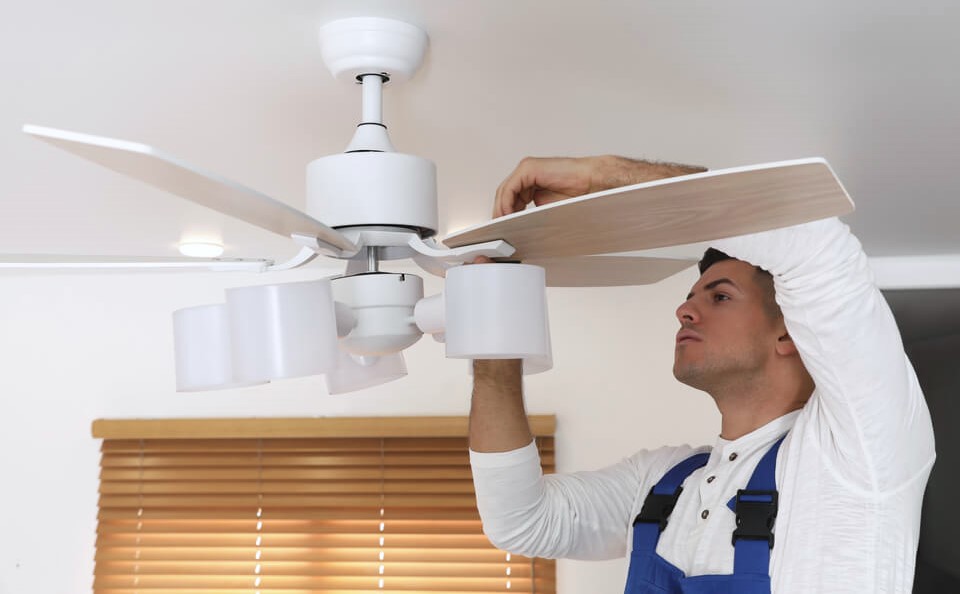
Why ceiling fan over air conditioning?
Ceiling fans have long been the go-to solution for an affordable cool-down during the warm Aussie summers. Below are the benefits of using ceiling fans in your home.
Cost-effectiveness
Compared to air conditioners, ceiling fans are a much more affordable option. They have a lower upfront cost and use significantly less electricity, translating to lower running costs on your electricity bill.
Energy Efficiency
Ceiling fans are the better option when it comes to energy efficiency. They create a cooling effect without needing to cool the air itself, making them a sustainable choice for your wallet and the environment.
They operate on a fraction of the electricity required by air conditioning units – a mere 30 times less, to be precise which translates to lower energy bills. For example, on average, running a ceiling fan costs a mere 2 cents per hour compared to an air conditioner.
The ceiling fan running costs, however, can vary depending on the type, size, speed, and wattage of the fan. Energy-efficient models, in particular, can significantly influence how much electricity is consumed.
Limitations of Ceiling Fans
Despite their benefits, ceiling fans have their drawbacks. Some of these include:
- Noise, which can disrupt the tranquillity of a space, especially in bedrooms
- Compromised room lighting, as ceiling fans are often installed in place of light fixtures
- Ceiling fans do not actually change the air temperature; they simply recirculate the existing air, which may not provide the desired level of cooling in extremely hot conditions.
Additionally, unlike air conditioners, ceiling fans do not offer air filtration or humidity control, which can be particularly disadvantageous in areas with high humidity levels.
If you end up choosing ceiling fans to cool your home, here’s our comprehensive ceiling fan installation guide to help you install your ceiling fan. If you’re not quite comfortable with electronics, leave it to the pros. Mr Sparky can take care of ceiling fan installation in your home and other electrical needs.
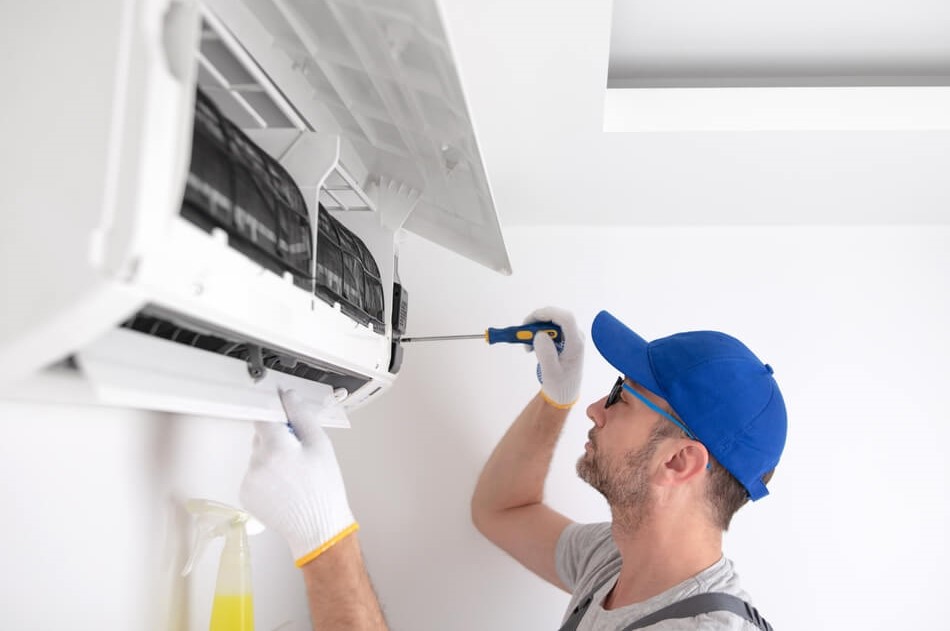
Air conditioner
Air conditioners offer powerful cooling, making them ideal for battling the intense heat in many areas of Australia. They are normally the preferred cooling option, especially during summer when the heat is intense and the humidity is off the charts.
You may be asking, how do air conditioners work?
Well, unlike ceiling fans, air conditioning units are a bit more complicated. Air conditioners use a refrigeration cycle to cool your home by constantly moving heat from inside to outside.
Warm air is drawn in and passed over coils with a liquid refrigerant that absorbs the heat and cools the air. A compressor then pressurises the hot gas, increasing its temperature and releasing it outside through condenser coils. A fan blows over these coils to dissipate the heat effectively.
The refrigerant then changes back into a liquid and returns inside to start the cycle again, continuously removing heat and keeping you comfortable.
Why should you go for air conditioning?
Air conditioning units, especially ducted air conditioning systems, provide cool air as needed. With the ability to maintain a consistent temperature and humidity level, these units offer not just comfort but a controlled environment tailored to our preferences.
Modern air conditioners also come equipped with air filters that capture dust, pollen, and other allergens, contributing to a healthier indoor air quality.
However, it’s not all breezy. The energy consumption of air conditioning can lead to a significant rise in utility bills particularly during those peak summer months,
Let’s take a closer look at the cost of comfort that comes with these units.
How much more energy does an air conditioner use compared to a ceiling fan?
While air conditioners provide unmatched cooling power, their energy consumption can be substantially higher than that of ceiling fans.
In fact, the energy used by a fan for an entire day could be equivalent to just 15 minutes of air conditioning use. When comparing costs, using an air conditioner for 8 hours daily can amount to around $120 per month, a big difference to the approximately $4.80 a month for a ceiling fan.
The cost of running an air conditioner is influenced by various factors, including:
- the system’s size and quality
- the efficiency of the model
- local electricity rates
- individual usage habits.
Are there energy-efficient air conditioning options that won’t skyrocket my electricity costs?
Yes, there are energy-efficient air conditioning options that can help you save on electricity costs. Different air conditioning systems offer varying levels of energy efficiency.
For example, split systems are generally more efficient compared to window or wall units, which, while less energy-efficient, can be an economical option for cooling smaller spaces or rental properties.
Make sure to look for split-type air conditioners with a high Energy Efficiency Ratio (EER).
The initial investment and ongoing running costs are critical considerations when deciding on an air conditioning unit, as they can represent a significant portion of one’s energy bill.
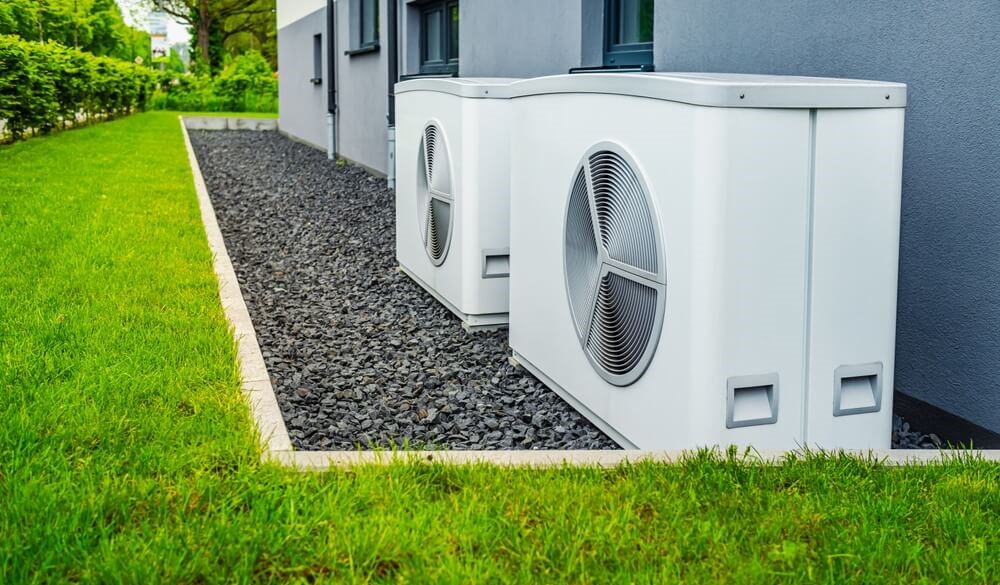
So, what’s the better option: ceiling fan or air conditioner?
When choosing between a ceiling fan and an air conditioner, you must consider considering several factors such as:
- climate
- budget
- personal preferences
- installation costs
When it comes to installation, ceiling fans are relatively easy on the wallet as they are pretty easy to install. Ceiling fan installation may cost between $100 to $300.
Air conditioning systems, on the other hand, may require invasive installations, especially the split system air conditioner so you should expect a higher installation cost.
It would be best if you also considered your personal comfort preferences when making a decision. Some individuals may find the superior cooling ability of air conditioners to be non-negotiable, while others may prefer the cost-effectiveness of ceiling fans, especially during milder days.
Another option you might want to check out is a portable air conditioner. They offer a degree of flexibility, easily moved to where cooling is most needed, and consequently, they can be a wise choice for targeted cooling and energy savings.
Ultimately, the ideal cooling solution should align with your specific living situation, climate, and comfort requirements.
Best option: choose both a ceiling fan and air conditioner
Why choose one when you can harness the power of both? Combining ceiling fans with air conditioners can be a game-changer, offering the best of both worlds. By using ceiling fans to circulate the air, you can:
- Set the thermostat on the air conditioner higher and still maintain the same level of comfort, thanks to the wind chill effect.
- Lower energy costs.
- Conserve energy, a significant benefit for both your wallet and the environment.
During the intense summer heat, this dual-method can ensure that you stay cool while also saving energy and money.


